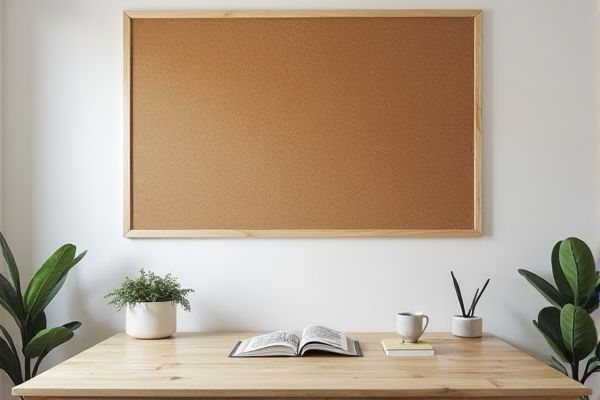
Magnetic boards offer a versatile surface for attaching notes and tools with magnets, while cork boards provide a traditional push-pin method ideal for quick and easy pinning of papers. Understanding the strengths of each can help you choose the best option for your organizational needs; continue reading to discover which board suits your space perfectly.
Table of Comparison
| Feature | Magnetic Board | Cork Board |
|---|---|---|
| Material | Steel or aluminum surface with magnetic properties | Natural cork surface |
| Usage | Holds magnets, papers, notes, photos | Holds push pins, notes, papers |
| Durability | Long-lasting, scratch-resistant | Prone to wear and tear from pinholes |
| Maintenance | Easy to clean, wipe with cloth | Requires occasional pinhole repair or replacement |
| Appearance | Sleek, modern look | Natural, rustic look |
| Size Options | Varied sizes, customizable | Varied sizes, customizable |
| Cost | Typically higher price point | Generally more affordable |
| Environmental Impact | Recyclable metal; longer lifespan reduces waste | Biodegradable cork; renewable resource |
| Best For | Office, classrooms, homes needing reusable display | Casual use, creative spaces, notice boards |
Introduction to Magnetic and Cork Boards
Magnetic boards use a steel or metal surface that attracts magnets, enabling users to easily attach notes, photos, and documents without damaging them. Cork boards consist of natural cork material that allows for pinning items with pushpins, providing a tactile and flexible display option. Both boards serve organizational and decorative purposes, but magnetic boards offer reusable attachment methods while cork boards require physical penetration of the surface.
Key Features of Magnetic Boards
Magnetic boards feature a smooth, durable steel surface compatible with magnets, allowing effortless attachment and repositioning of notes, photos, and documents. These boards offer versatility in organization, easy cleaning, and professional aesthetics, making them ideal for offices and classrooms. Your workspace can be enhanced by using magnetic boards for dynamic presentations and quick updates without damaging your materials.
Key Features of Cork Boards
Cork boards offer a natural, eco-friendly surface composed of compressed cork granules, providing a lightweight and durable option for pinning notes, photos, and reminders. Their self-healing property allows pinholes to close up after use, prolonging the board's lifespan and maintaining a clean appearance. You benefit from easy customization with a variety of sizes, frames, and mounting options to suit your workspace or home environment.
Durability and Longevity Comparison
Magnetic boards are typically made from steel or aluminum, offering superior durability and resistance to wear and tear compared to cork boards, which are prone to crumbling and damage over time. Cork boards may require frequent replacement due to their tendency to deteriorate from repeated pinning and environmental factors such as humidity. Your choice should consider magnetic boards for long-term use, especially in high-traffic or professional settings where resilience is essential.
Ease of Use and Installation
Magnetic boards offer straightforward installation with adhesive backings or wall mounts, enabling quick setup without tools. Cork boards often require screws or nails, which may involve more effort and wall damage. Magnetic boards provide easier use for frequent item updates due to reusable magnets, whereas cork boards need pins that can deteriorate over time.
Aesthetic Appeal and Design Options
Magnetic boards offer sleek, modern aesthetics with smooth surfaces available in various colors and finishes, making them ideal for contemporary spaces. Cork boards provide a natural, rustic charm with textured surfaces that complement traditional or cozy interiors and allow for easy pinning of notes and photos. Your choice depends on whether you prefer the clean, versatile look of magnetic boards or the warm, tactile appeal of cork boards to enhance your space's design.
Maintenance and Cleaning Requirements
Magnetic boards require minimal maintenance, as they can be wiped clean effortlessly with a dry or slightly damp cloth, preventing residue buildup from magnets or markers. Cork boards demand more upkeep to manage pinholes and occasional crumbling, often needing replacement or repair to maintain an even surface. Your choice between these boards will affect how much time and effort you spend on cleaning and maintenance.
Best Use Cases for Magnetic Boards
Magnetic boards excel in environments that require frequent updates and versatile display options, making them ideal for offices, classrooms, and creative studios where you can easily attach notes, presentations, and tools with magnets. Unlike cork boards, magnetic boards allow for quick repositioning of materials without damaging surfaces, enhancing organization and visual communication. Your productivity improves by combining writing capabilities with magnetic attachments, supporting dynamic workflows and collaboration.
Best Use Cases for Cork Boards
Cork boards excel in environments where frequent pinning and easy repositioning of lightweight items like notes, photos, and schedules are needed, making them ideal for classrooms, offices, and home organization. Their natural texture and durability allow for repeated use without damaging the surface or the pinned materials, supporting long-term, dynamic information display. Cork boards also offer an eco-friendly option compared to synthetic alternatives, appealing to sustainable design preferences in various settings.
Which Board is Best for Your Needs?
Magnetic boards offer versatile use with strong holding power for documents, photos, and reminders using magnets, making them ideal for dynamic, frequently updated displays in offices or classrooms. Cork boards provide a natural, tactile surface for pinning notes, cards, and lightweight items, preferred in creative or home environments where aesthetics and easy rearrangement are key. Choosing the best board depends on whether you prioritize quick, flexible changes with magnets or a more traditional, textured space for push pins and softer visuals.
 homyna.com
homyna.com